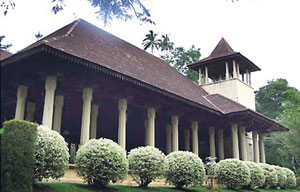The angels, had they descended, would have appreciated the delectable presentation of choral music at the Trinity College Chapel on Sunday, June 6.
The programme started as early as 3.30 in the afternoon to accommodate a multitude of choirs from as many as seven schools. They were St. John's from far flung Jaffna; Bishop's from Colombo; St Anthony's, Katugastota; Mowbray, Hillwood, Good Shepherd Convent and Trinity from Kandy. Even the guest preacher, Rev.Fr. Araliya Jayasundera, OSB., though a Trinitian, arrived from the Eastern Province to give a heart warming message.
 |
| The Trinity chapel. Pic courtesy panoramio.com |
Each choir excelled and held its own in caressingly choired hymns. The Bible readings and offertory prayers were mellifluous and accepted with much emotion.
The original hymn that wafted the air was 'You are Worthy' arranged by the late Ruwani Seimon and maintained the timbre of the occasion.
Comparisons are odious but as a Trinitian of the vintage years I was moved to observe the mercurial kinematic advances the Trinity Choir has made under the tutelage of Lasantha Tennekoon and recall that under Major Gordon Burrows the Trinity choir was spoken of in the same breath as that of King's College, London.
A few words about the Trinity College Chapel as elaborated by Paul Jeyaraj and Sujatha Kuruwita in the fine brochure produced for the occasion:-
'Oakley's Church', built in 1858 was far too small. So, Mr. Fraser chose the most commanding site in the compound and set to work, to build for posterity, to build a thing of beauty, and to build in the vernacular.
He had in his Vice Principal, Rev. Gaster an architect and draughtsman of technical skill. It is to Rev. Gaster that the credit should go for embarking on this great adventure, of designing and preparing the plans for construction. He was influenced by what he saw at Polonnaruwa and what had deeply impressed upon him - the remarkable ruins and their grandeur, their massiveness and their loveliness.
Principal Campbell took over the responsibility of collecting funds to continue with the building of the Chapel which was completed in 1932 and was ready for use in 1935. He saw to its completion with Mr K.L.B.Tennekoon and Mr H.W.Mediwake who were directly concerned with the building construction.
Sixty six pillars rise twenty feet above ground level. They are 16 foot monoliths, square based, square capped but the main stem is octagonal with carved 'pekadas' skilfully designed by Mr Bezalel Navaratne. The bell shaped beams have mouths of full blown inverted lotus. These pillars support a great sweeping roof of a span of 75 feet.
Four pillars at the northern entrance carry carvings of the 'four beasts' of Revelation 4:7. From early times they have been regarded as symbols of the four Gospel writers, Matthew, Mark, Luke and John. The great structure is constructed with granite of grey from ground level to the top of pillars and walls. 'Pekadas' and 'pekada beams are of Gammalu timber.
The stone was brought from Aruppola. Split pillar blocks 18 feet long and 3 feet square were loaded on trolleys specially made for transporting one pillar at a time. One elephant pulled the trolley and another pushed from behind. They were brought at the rate of 2 per month.
The Bell Tower was started in 1965 by Mr Barney Raymond, an Old Boy, who donated ten slabs which were needed to complete the Tower. The Tower was dedicated on the 8th of December 1969 in memory of Rev. Cannon John McLeod Campbell by the First Bishop of Kurunegala Rt. Rev. Lakdasa de Mel who himself was enthroned at the Trinity Chapel.
An old boy, David Paynter painted the murals. The key figures and scenes are depicted in a manner to give the Biblical story a local setting and an indigenous character. Jesus is depicted as a young man of around thirty, Asian in appearance and features and beardless. These Chapel murals are regarded as unique examples of Christian art in Asia.
The Chapel forms the central part of life at Trinity. Except on school holidays it is regularly used for Christian worship with short services on Tuesdays and Thursdays and regular Sunday Services. There are special services to mark the main events in the Christian calendar. The Chapel is the heart of the school.
|


